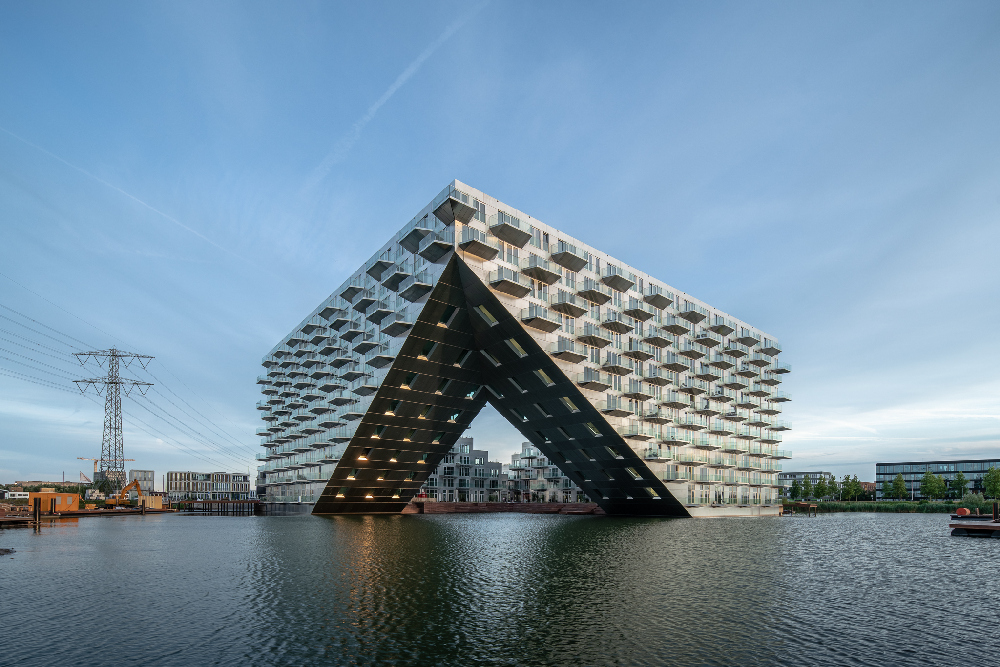
After four years of construction, Sluishuis has been completed. Amsterdam IJburg, located in the Netherlands, now has a new, architecturally iconic landmark. The building forms a bridge between IJburg and the city center. With 442 different types of owner-occupied and rental homes, a public greenroof garden with a rooftop walkway, bird and recreational islands, jetties for boats and catering facilities, Sluishuis is a place for everyone.
The building started when the municipality of Amsterdam declared the combination VORM and BESIX RED winner of the quality tender for the development and construction of Sluishuis in 2016. For the design of this unique building, the developer’s group joined forces with architects Bjarke Ingels Group and Dutch Barcode Architects. They entrusted the complex construction to BESIX Nederland and VORM Bouw. The result of their shared vision is an iconic development in which sustainability and the well-being of residents and visitors are key.
Sluishuis offers a modern and sustainable way of living on and around water. It is a remarkable building with a unique volume that seems to float over the water thanks to a double cantilever. The cantilevers come together in a high corner that form a large gateway, as if it were an opening sluice, from the IJ to the inner harbor of the building. On the other side, the building is complemented with stairs leading toward its rooftop and green, welcoming terraces.
Sluishuis consists of energy-neutral, owner-occupied and rental apartments and an offer featuring houseboat lots, jetties for pleasure crafts, catering facilities, commercial spaces and a fully integrated water landscape with islands for recreation, water sports, fauna and flora and even power generation. The project is largely publicly accessible. Residents and visitors can linger in the inner harbor, enjoy the promenade with stunning rooftop views and benefit from the jetties and islands, spot water birds or admire the historic houseboats.
The sustainability of Sluishuis is an integral part of the project. With an energy-performance coefficient of 0.00, the building generates more energy than it consumes. The building’s heating requirements are minimized by combining high-performance insulation techniques, triple glazing and heat recovery on the ventilation systems and wastewater. Energy consumption is further reduced by a heat and cold storage system in the ground for heat and cooling in combination with a connection to the district heating system for peak times. The remaining energy consumption for heating, heat pumps, ventilation and LED lighting is fully compensated by approximately 2,200 square meters of solar panels, to which an entire floating island adjacent to the project is dedicated. The development team of Sluishuis paid particular attention to green space and water collection. The front sides and the inner harbor of the building feature gardens with local plant species. The greenery runs across the roof terraces up into integrated planters, creating a pleasant green atmosphere.
In addition to the building’s sustainable features, Sluishuis aims to stimulate and strengthen the social connections between residents and visitors. The staggered balconies encourage relationships and exchanges. The public walkway toward the rooftop, but also the children’s playground in the inner harbor, the landscape with jetties and the wooden roof terraces promote spontaneous encounters.
The building materials contrast and connect with their environment. Natural materials were chosen for their material palette, which will give the building a rich and natural look over the years. The abstract, untreated aluminum of the façade reflects the water and gives the volume a different look at any time of day. In contrast, the stepped roof terraces and the jetties landscape are made of wood, which gives a tactile appearance. The building’s façade is circular.



 Join our thriving community of 70,000+ superintendents and trade professionals on LinkedIn!
Join our thriving community of 70,000+ superintendents and trade professionals on LinkedIn! Search our job board for your next opportunity, or post an opening within your company.
Search our job board for your next opportunity, or post an opening within your company. Subscribe to our monthly
Construction Superintendent eNewsletter and stay current.
Subscribe to our monthly
Construction Superintendent eNewsletter and stay current.